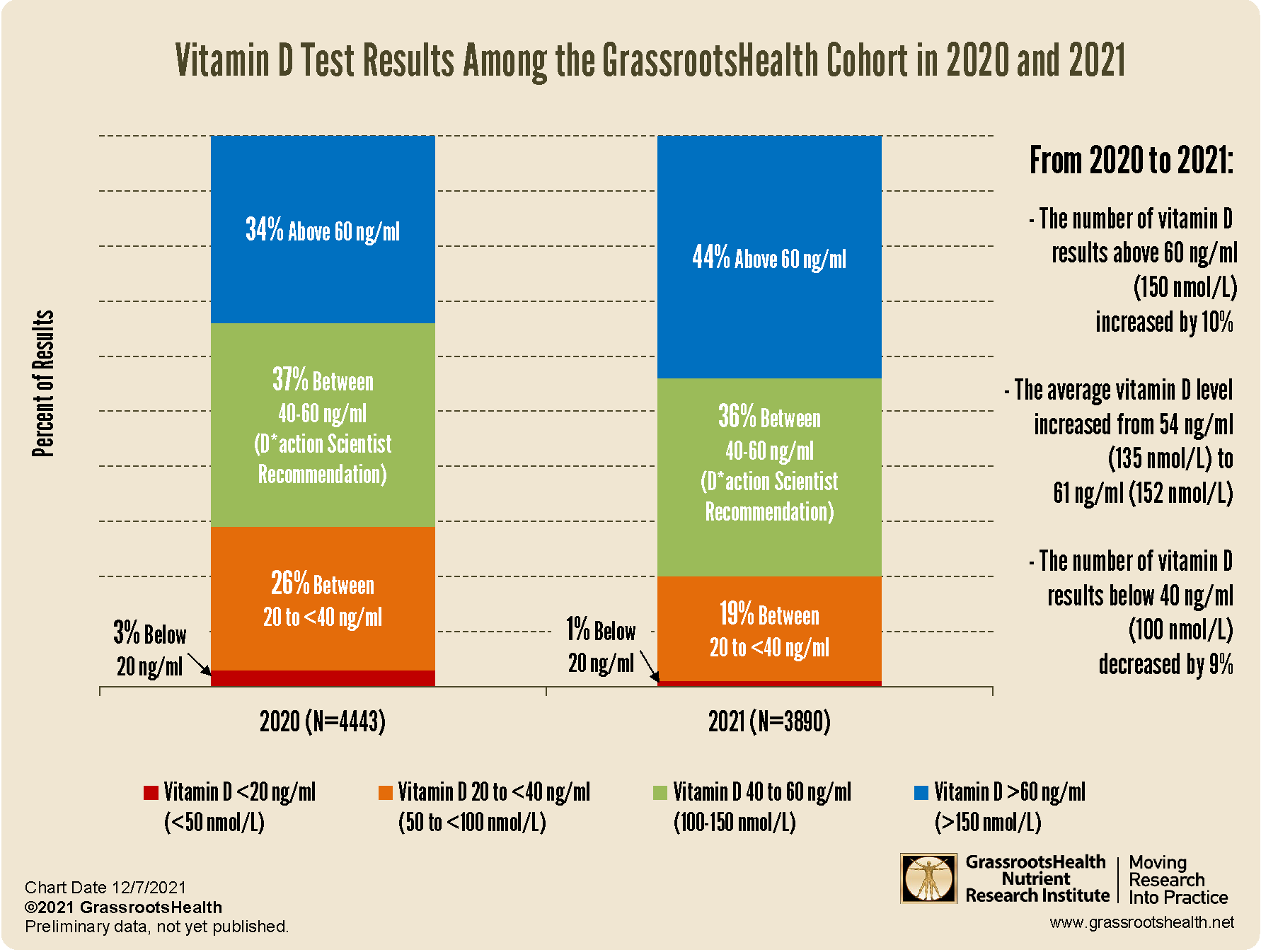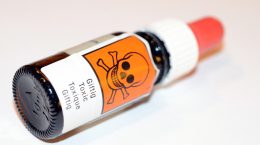Published on December 8, 2021
10% more vitamin D results above 60 ng/ml were posted so far in 2021 than in 2020. Have your levels increased? How much is too much, and when is vitamin D toxicity a concern?
Key Points
- Average vitamin D levels posted to GrassrootsHealth participants have increased from an average of 54 ng/ml (135 nmol/L) in 2020 to an average of 61 ng/ml (152 nmol/L) in 2021
- 44% of the results posted through the beginning of December, 2021, were above 60 ng/ml (150 nmol/L)
- Levels in excess of 150 ng/ml may raise the concern for vitamin D toxicity, however, vitamin D toxicity is one of the rarest medical conditions, with a meta-analysis showing no toxicity below a vitamin D level of 200 ng/ml (500 nmol/L) or below a vitamin D intake of 30,000 IU/day
 First off, thank you and congratulations to all of the participants (we call them Citizen Scientists) who have contributed their data to the D*action study and taken steps to improve their vitamin D level, and their health!
First off, thank you and congratulations to all of the participants (we call them Citizen Scientists) who have contributed their data to the D*action study and taken steps to improve their vitamin D level, and their health!
A preliminary analysis of the GrassrootsHealth data from 2020 and 2021 (through the beginning of December) shows that
- in 2020, 29% of the vitamin D results were below 40 ng/ml (100 nmol/L), and 34% were above 60 ng/ml (150 nmol/L), with an average result of 54 ng/ml (135 nmol/L)
- in 2021 (as of the beginning of December), 20% of the vitamin D results were below 40 ng/ml and 44% were above 60 ng/ml, with an average result of 61 ng/ml (152 nmol/L)
- there was a 10% increase in the number of vitamin D results that were over 60 ng/ml, with 9% fewer results below 40 ng/ml
Are Vitamin D Levels Above 60 ng/ml Safe?
We have been receiving more questions from participants about whether a vitamin D result above the scientists’ recommended range of 40-60 ng/ml (100-150 nmol/L) is too high. This recommended range is for general health, and is based on overwhelming evidence about the association between vitamin D and the reduced risk of many diseases including bone diseases (rickets, osteomalacia, and osteoporosis), multiple sclerosis, diabetes, cancer, and many others.
There is evidence that levels above 60 ng/ml provide additional benefit, especially for breast cancer prevention and treatment of autoimmune diseases. GrassrootsHealth considers levels between 60 and 100 ng/ml (150-250 nmol/L) to be safe and in the high end of a normal range.
When Could Vitamin D Toxicity be a Concern?
We do not currently have data to support any additional health benefit of having a vitamin D level above 100 ng/ml. Levels in excess of 150 ng/ml raise the concern for vitamin D toxicity which is most frequently diagnosed when levels are over 200 ng/ml (500 nmol/L), though not everyone who reaches that level experiences toxicity.
Vitamin D toxicity occurs when high vitamin D levels (typically, over 200 ng/ml) cause high calcium levels, called hypercalcemia. Symptoms of hypercalcemia include loss of appetite, feeling very thirsty, weight loss, constipation or diarrhea, abdominal pain, musculoskeletal pain, or feeling sick, confused, or tired.
According to a Mayo Clinic publication, “There is enough evidence that vitamin D toxicity is one of the rarest medical conditions and is typically due to intentional or inadvertent intake of extremely high doses of vitamin D (usually in the range of >50,000 – 100,000 IU/day for months to years) without monitoring for hypercalcemia.” In fact, a meta-analysis of 15 clinical trials found no toxicity below a vitamin D level of 200 ng/ml (500 nmol/L) or below a vitamin D intake of 30,000 IU/day.
In an upcoming post, we will address another question we have been receiving from participants whose vitamin D level is higher than what they’d like it to be… How can I lower my vitamin D level?
What is YOUR Vitamin D Level? Have You Tested This Year?
 Having and maintaining healthy vitamin D levels and other nutrient levels can help improve your health now and for your future. Choose which to measure, such as your vitamin D, omega-3s, and essential minerals including magnesium and zinc, by creating your custom home test kit today. Take steps to improve the status of each of these measurements to benefit your overall health. You can also track your own intakes, symptoms and results to see what works best for YOU.
Having and maintaining healthy vitamin D levels and other nutrient levels can help improve your health now and for your future. Choose which to measure, such as your vitamin D, omega-3s, and essential minerals including magnesium and zinc, by creating your custom home test kit today. Take steps to improve the status of each of these measurements to benefit your overall health. You can also track your own intakes, symptoms and results to see what works best for YOU.
Enroll and test your levels today, learn what steps to take to improve your status of vitamin D (see below) and other nutrients and blood markers, and take action! By enrolling in the GrassrootsHealth projects, you are not only contributing valuable information to everyone, you are also gaining knowledge about how you could improve your own health through measuring and tracking your nutrient status, and educating yourself on how to improve it.






